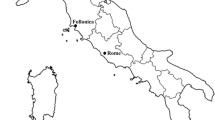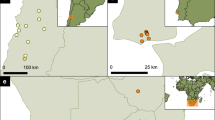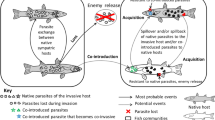Abstract
The enemy release hypothesis (ERH) postulates that during the invasion process an introduced species is released from the natural enemies that regulate its populations, promoting its invasion success in the new environment. Callosciurus erythraeus is a sciurid native to Southeast Asia that has been successfully introduced into Argentina and other Asian and European countries. The aim of this study was to provide new parasitological data on this species and to compare it with studies in native and other introduced ranges under the framework of the ERH. We proposed two working hypotheses: (1) an analysis at the community level to compare the prevalence, abundance and identity of parasites of C. erythraeus and sympatric native mammals in the main invasion focus of Argentina, and (2) an analysis at the biogeographical level to compare parasite richness in native and introduced ranges of C. erythraeus and parasite prevalence and richness among introduced regions with different invasion success (using population density and spread as proxy variables). The community analyses indicated that C. erythraeus has lost its specific parasites in Argentina and that it has a lower level of parasitism than other native mammals. The biogreographical analyses indicated a lower macroparasite richness of C. erythraeus in introduced ranges compared to its native range. However, parasite richness in introduced ranges was not associated with population density and spread. The negative correlation between parasite prevalence and population parameters was mainly due to the low parasite prevalence of C. erythraeus in Argentina where this species shows high density and spread. The release of parasites of C. erythraeus in comparison to its native and other introduced ranges, the low acquisition of generalist parasites and the high population density and spread reached in Argentina are mostly in agreement with the expected outcomes based on the ERH. Further studies are needed to better understand the role of the ERH in the invasion success of this species.


Similar content being viewed by others
References
Adriaens T, Baert K, Breyne P, Casaer J, Devisscher S, Onkelinx T, Pieters S, Stuyck J (2015) Successful eradication of a suburban Pallas’s squirrel Callosciurus erythraeus (Pallas 1779) (Rodentia, Sciuridae) population in Flanders (northern Belgium). Biol Inv 17:2517–2526
Asakawa M (2005) Perspectives of host–parasite relationships between rodents and nematodes in Japan. Mammal Study 30:S95–S99
Benitez VV, Almada Chávez S, Gozzi AC, Messetta ML, Guichón ML (2013) Invasion status of Asiatic red-bellied squirrels in Argentina. Mamm Biol 78:143–153
Blagoveshchenskiy DI (1972) Mallophaga and Anoplura from some mammals of China and Vietnam. Entomol Rev 51:185–190
Brooks DR, Hoberg EP (2007) How will global climate change affect parasite–host assemblages? Trends Parasitol 23:571–574
Bush AO, Lafferty KD, Lotz JM, Shostak AW (1997) Parasitology meets ecology on its own terms: Margolis et al. Revisited. J Parasitol 83:575–583
Chemisquy MA, Martin GM (2019) Didelphis albiventris. In: SAyDS–SAREM (eds) Categorización 2019 de los mamíferos de Argentina según su riesgo de extinción. Lista Roja de los mamíferos de Argentina. http://cma.sarem.org.ar. Accessed 30 Dec 2019
Chin TH (1979) A new species of the family Enderleinellidae Anoplura. Entomotaxonomia 1:121–124
Colautti RI, Ricciardi A, Grigorovich IA, MacIsaac HJ (2004) Is invasion success explained by the enemy release hypothesis? Ecol Lett 7:721–733
Combes C (2001) Parasitism: the ecology and evolution of intimate interactions. University of Chicago Press, Chicago
Dozières A, Pisanu B, Gerriet O, Lapeyre C, Stuyck J, Chapuis JL (2010) Macroparasites of Pallas’s squirrels, Callosciurus erythraeus, introduced into Europe. Vet Parasitol 172:172–176
Dunn AM (2009) Parasites and biological invasions. In: Webster JP (ed) Natural History of Host-Parasite Interactions. Advances in Parasitology, vol 68. pp 161–184
Dunn AM, Torchin ME, Hatcher MJ, Kotanen PM, Blumenthal DM, Byers JE, Coon CAC, Frankel VM, Holt RD, Hufbauer RA, Andrew R, Kanarek AR, Schierenbeck KA, Wolfe LM, Perkins SE (2012) Indirect effects of parasites in invasions. Funct Ecol 26:1262–1274
Durden LA, Beaucournu J-C (2014) Three new species of fleas belonging to the genus Macrostylophora from the three-striped ground squirrel, Lariscus insignis, in Java. Med Vet Entomol 28:398–406
Durden LA, Musser GG (1994) The sucking lice (Insecta, Anoplura) of the World. A taxonomic checklist with records of mammalian hosts and geographical distributions. Bull Am Mus Nat Hist 218:1–90
Durette-Desset MC (1970) Brevistriata bergerardi, noveau nématode heligmosome, parasite d’un écureuill de Corée. Bull Mus Natl Hist Nat 42:419–423
Fischthal JH, Kuntz RE (1981) Additional records of digenetic trematodes of mammals from Taiwan. Proc Helminthol Soc Wash 48:71–79
Fitte B, Robles MR, Dellarupe A, Unzaga JM, Navone GT (2017) Hymenolepis diminuta and Rodentolepis nana (Hymenolepididae: Cyclophyllidea) in urban rodents of Gran La Plata: association with socio-environmental conditions. J Helminthol. https://doi.org/10.1017/S0022149X17000864
Furman DP (1972) Laelapid mites (Laelapidae: Laelapinae) of Venezuela. Brigh Young Sci Bull Biol Ser 27:1–58
Gannon WL, Sikes RS (2007) The animal care and use committee of the American Society of Mammalogists. Guidelines of the American Society of Mammalogists for the use of wild mammals in research. J Mammal 88:809–823
Gendron AD, Marcogliese JD, Thomas M (2012) Invasive species are less parasitized than native competitors, but for how long? The case of the round goby in the Great Lakes-St. Lawrence Basin. Biol Inv 14:367–384
Gómez Muñoz MA, Robles MR, Milano AMF, Navone GT (2018) Helminth infection levels on Rattus rattus (Rodentia: Muridae) from Corrientes City, Argentina. Mastozoología Neotropical 25:221–227
Gómez Villafañe IE, Miñarro F, Ribicich M, Rossetti CA, Rossotti D, Busch M (2004) Assessment of the risks of rats (Rattus norvegicus) and opossums (Didelphis albiventris) in different poultry-rearing areas in Argentina. Braz. J. Microbiol 35:359–363
Gómez Villafañe IE, Miño M, Cavia R, Hodara K, Courtalón P, Suárez O, Busch M (2005) Guía de roedores de la provincia de Buenos Aires. L.O.L.A, Buenos Aires
Gómez Villafañe IE, Robles MR, Busch M (2008) Helminth communities and host-parasite relationships in argentine brown rat (Rattus norvegicus). Helminthologia 45:126–129
Gozzi (2015) Estudios parasitológicos y zoonóticos de la ardilla de vientre rojo Callosciurus erythraeus introducida en Argentina y su relación con la comunidad de mamíferos del ambiente receptor. Dissertation, Universidad Nacional de Luján
Gozzi AC, Guichón ML, Benitez VV, Lareschi M (2013) Arthropod parasites of the red-bellied squirrel Callosciurus erythraeus introduced into Argentina. Med Vet Entomol 27:203–208
Gozzi AC, Guichón ML, Benitez VV, Troyelli A, Navone GT (2014) Gastro-intestinal helminths in the red-bellied squirrel introduced in Argentina: accidental acquisitions and lack of specific parasites. Hystrix 25:97–102
Guichón ML, Doncaster CP (2008) Invasion dynamics of an introduced squirrel in Argentina. Ecography 31:211–220
Guichón ML, Benitez VV, Gozzi AC, Borgnia M, Hertzriken M (2015) From a lag in vector activity to a constant increase of translocations: invasion of Callosciurus squirrels in Argentina. Biol Invasions 17:2597–2604
Guichón ML, Benítez V, Borgnia M, Gozzi C, Aprile G, Pedreira P (2019) Callosciurus erythraeus. In: SAyDS–SAREM (Eds) Categorización 2019 de los mamíferos de Argentina según su riesgo de extinción. Lista Roja de los mamíferos de Argentina. http://cma.sarem.org.ar. Accessed 30 Dec 2019
Hancke D (2016) La comunidad de helmintos en roedores sinantrópicos de la Ciudad de Buenos Aires: su relación con los ensambles de especies hospedadoras y su importancia zoonótica. Dissertation, Universidad Nacional de Buenos Aires
Heger T, Jeschke JM (2014) The enemy release hypothesis as a hierarchy of hypotheses. Oikos 123:741–750
Hoogstraal H, Kohls GM (1965) Description, hosts, and ecology of Ixodes kuntzi n. sp., Kuntz’s Taiwan flying squirrel tick (Ixodoidea; Ixodidae). J Med Entomol 2:209–214
Huang LQ, Guo XG, Wu D, Zhou DH (2010) Distribution and ecological niches of Gamasid Mites (Acari: Mesostigmata) on small mammals in Southwest China. Psyche, Article ID 934508, p 12
Hufbauer RA, Torchin ME (2007) Integrating ecological and evolutionary theory of biological invasions. In: Nentwig W (ed) Biological invasions. Ecological Studies Springer, Berlin, pp 79–96
Jeschke JM, Heger T (2018) Enemy Release Hypothesis. In: Jeschke JM, Heger T (eds) Invasion biology: hypotheses and evidence. CABI, Boston, pp 92–102
Jeschke JM, Gómez Aparicio L, Haider S, Heger T, Lortie CJ, Pyšek P, Strayer D (2012) Support for major hypotheses in invasion biology is uneven and declining. NeoBiota 14:1–20
Jordan K (1932) Siphonaptera collected by Harold Stevens on the Kelley-Roosevelt expedition in Yunnan and Szechuan. Novitates Zoologicae 38:276–290
Kaneko K (1954) Description of a new species of Enderleinellus collected from the South Formosa squirrel naturalized into Japan. Bull Tokyo Med Dent Univ 1:49–52
Keane RM, Crawley MJ (2002) Exotic plant invasions and the enemy release hypothesis. Trends Ecol 17:164–170
Kelly DW, Paterson RA, Townsend CR, Poulin NR, Tompkins DM (2009) Parasite spillback: a neglected concept in invasion ecology? Ecol 90:2047–2056
Kliks M, Durette-Desset MC (1976) Brevistriatinae (Nematoda: Heligmosomidae) II. Description de Calypsostrongylus titasuthi n. sp., parasite de Callosciurus flavimanus en Thailande. Bull Mus Natl Hist Nat 270:685–692
Kobayashi S, Denda T, Placksanoi J, Waengsothorn S, Aryuthaka C, Panha S, Izawa M (2019) The pollination system of the widely distributed mammalpollinated Mucuna macrocarpa (Fabaceae) in the tropics. Ecol Evol. https://doi.org/10.1002/ece3.5201
Kołodziej-Sobocińska M (2019) Factors affecting the spread of parasites in populations of wild European terrestrial mammals. Mammal Res 64:301–318
Koyabu D, Oshida T, Nguyen ST, Dang CN, Nguyen NX, Nguyen DX, Motokawa M, Kimura J, Sasaki M, Endo H (2012) Comparison of jaw muscle morphology in two sympatic callosciurine squirrels (Callosciurus erythraeus and Dremomys rufigenis) in Vietnam. Mammal Study 37:237–242
Krantz GW, Walter DE (eds) (2009) A manual of acarology. Texas Tech University Press, Lubbock
Krasnov BR, Poulin R (2010) Ecological properties of a parasite: species-specific stability and geographical variation. In: Morand S, Krasnov BR (eds) The biogeography of host-parasite interactions. Oxford University Press, New York, pp 99–113
Lareschi M, Mauri R (1998) Dermanyssoidea. In: Morrone JJ Coscarón S (Eds) Biodiversidad de Artrópodos Argentinos Una perspectiva biotaxonómica, Ediciones Sur, La Plata, pp 581–590
Lareschi M, Sanchez J, Autino A (2016) A review of the fleas (Insecta- Siphonaptera) from Argentina. Zootaxa 4103:239–258
Li KC, Hsieh PC, Yang HT (1976) A new species of the genus Macrostylophora (Siphonaptera Ceratophyllidae). Acta Entomol Sin 19:345–347
Lin S, Yo SP (1981) Population dynamics of the red-bellied tree squirrel (Callosciurus erythraeus). Bull Inst Zool Acad Sin 20:31–41
Linardi PM, Guimarães LR (2000) Siphonápteros do Brasil. Museu de Zoologia Universidad de São Paulo/Fundação de Amparo ã Pesquisa do Estado de São Paulo, São Paulo
Liu H, Stiling P (2006) Testing the enemy release hypothesis: a review and meta-analysis. Biol Inv 8:1535–1545
Liu CY, Zhang D, Liu Q (1982) Notes on Megathoracipsylla pentagonia and its unknown female (Siphonaptera Ceratophyllidae). Entomotaxonomia 4:37–38
Lowry E, Rollinson EJ, Laybourn AJ, Scott TE, Aiello-Lammens ME, Gray SM, Mickley J, Gurevitch J (2013) Biological invasions: a field synopsis, systematic review, and database of the literature. Ecol Evol 1:182–196
Lurz PWW, Hayssen V, Geissler K, Bertolino S (2013) Callosciurus erythraeus (Rodentia: Sciuridae). Mamm Species 45:60–74
MacLeod CJ, Paterson AM, Tompkins DM, Duncan RP (2010) Parasites lost—do invaders miss the boat or drown on arrival? Ecol Lett 13:516–527
Marshall AG (1981) The ecology of ectoparasitic insects. Academic Press Inc, New York
Matsudate H, Moyoshi Y, Tamura N, Murata K, Maruyama S, Kimura J, Nogami S, Maeda K, Fukumoto Y, Akasako R, Asakawa M (2003) A survey of the parasitic helminths of alien rodents (belly-banded squirrel Callosciurus erythraeus and nutria Myocastor coypus) in Japan. J Zoo Wildl Med 8:63–67
Mazzamuto MV, Bisi F, Wauters LA, Preatoni DG, Martinoli A (2016a) Interspecific competition between alien Pallas’s squirrels and Eurasian red squirrels reduces density of the native species. Biol Inv. https://doi.org/10.1007/s10530-016-1310-3
Mazzamuto MV, Pisanu B, Chapuis J-L, Romeo C, Ferrari N, Wauters L, Preatoni D, Martinoli A (2016b) Poor parasite community in an invasive alien species: macroparasites of Pallas’s squirrels in Italy. Ann Zool Fennici 53:1–2
Messetta ML, Milesi FA, Guichón ML (2015) Impacto de la ardilla de vientre rojo sobre la comunidad de aves en la Región Pampeana, Argentina. Ecol Austral 25:37–45
Miyabe S, Miyamoto A, Yokohata Y, Yasuda M (2016) Gastrointestinal parasitic helminth fauna of the Pallas’s Squirrel (Callosciurus erythraeus) from the Uto Peninsula, Kumamoto, Kyushu, Japan and analyses of the abundance of an alien nematode, Strongyloides callosciureus. Parasitol. https://doi.org/10.5686/jjzwm.21.29
Myers JB, Kuntz RE (1964) Nematode parasites from mammals taken on Taiwan (Formosa) and its Offshore Islands. Can J Zool 42:863–867
Patton J, Pardiñas UFJ, D’Elia G (eds) (2015) Mammals of South America, vol 2. The University of Chicago Press, Chicago
Poulin R (2007) Evolutionary ecology of parasites, 2nd edn. Princeton University Press, Princeton
Prenter J, MacNeil C, Dick JTA, Alison M, Dunn AM (2004) Roles of parasites in animal invasions. Trends Ecol Evol. https://doi.org/10.1016/j.tree.2004.05.002
Prior KM, Hellmann JJ (2015) Does enemy release contribute to the success of invasive species? A review of the enemy release hypothesis. In: Keller R, Cadotte M, Sandiford G (eds) Invasive species in a globalized world. University of Chicago Press, Chicago, pp 252–280
Prior KM, Powell THQ, Joseph AL, Hellmann JJ (2014) Insights from community ecology into the role of enemy release in causing invasion success: the importance of native enemy effects. Biol Inv 17:1283–1297
Santicchia F, Romeo C, Martinoli A, Lanfranchi P, Wauters L, Ferrari N (2015) Effects of habitat quality on parasite abundance: do forest fragmentation and food availability affect helminth infection in the Eurasian red squirrel? J Zool 296:38–44
Sato H, Torii H, Une Y, Ooi HK (2007) A new Rhabditoid nematode species in Asian Sciurids, distinct from Strongyloides robustus in north American Sciurids. J Parasitol 93:1476–1486
Schmidt B, Myers J, Kuntz RE (1967) Nematode Parasites of Oceanica. I. Brevistriata sundasciuri sp. n. and Calypsostrongylus ogdeni gen. et sp. n. (Heligmosomatidae: Longistriatinae) from Squirrels of Palawan and Taiwan. J Parasitol 53:613–617
Shea K, Chesson P (2002) Community ecology theory as a framework for biological invasions. Trends Ecol Evol 17:170–176
Shinozaki Y, Shiibashi T, Yoshizawa K, Murata K, Kimura J, Maruyama S, Hayama H, Yoshida H, Nogami S (2004) Ectoparasites of the Pallas squirrel, Callosciurus erythraeus, introduced to Japan. Med Vet Entomol 18:61–63
Smit FGAM (1987) An ilustrated catalogue of the Rothschild Collection of fleas (Siphonaptera) in the British Museum (Natural History), Malacopsylloidea (Malacopsyllidae and Rhopalopsyllidae). Oxford University, London
Strandtmann RW, Wharton GW (1958) A manual of Mesostigmatid mites parasitic on vertebrates. The Institute of Acarology, College Park
Tamura N (2004) Population dynamics and expansion of introduced Formosan squirrels in Kanagawa Prefecture, Japan. Jpn J Conserv Ecol 9:37–44
Tamura N, Hayashi F, Miyashita K (1989) Spacing and kinship in the Formosan squirrel living in different habitats. Oecologia 79:344–352
Timmins RJ, Duckworth JW (2008) Diurnal squirrels (Mammalia Rodentia Sciuridae) in Lao PDR: distribution, status and conservation. Trop Zool 21:11–56
Torchin ME, Mitchell CE (2004) Parasites, pathogens, and invasions by plants and animals. Front Ecol Environ 2:183–190
Torchin ME, Lafferty KD, Dobson AP, McKenzie VJ, Kuris AM (2003) Introduced species and their missing parasites. Nature 421:628–630
Traub R (1972) The Gunong Benom expedition 1967. Notes on zoogeography, convergent evolution and taxonomy of fleas (Siphonaptera), based on collections from Gunong Benom and elsewhere in South-East Asia. III Zoogeography. Bull br Mus nat Hist Zool 23:389–450
Vignau ML, Venturini LM, Romero JR, Eiras DF, Basso WU (2005) Parasitología práctica y modelos de enfermedades parasitarias en los animales domésticos. Universidad Nacional de La Plata, La Plata, Facultad de Ciencias Veterinarias, p 193
Wang PQ (1981) Six new species of nematodes from vertebrates in Fujian Province. Acta Zootaxon Sin 6:365–372
Welbourn WC (2006) Key to the subfamilies of Cheyletidae, Key to the Genera of Cheyletinae (Acari: Raphignata). The Ohio State University Acarology Summer Program, Soil Acarology 253–291
Wilson K, Bjørnstad ON, Dobson AP, Merler S, Poglayen G, Randolph SE, Read AF, Skorping A (2002) Heterogeneities in macroparasite infections: patterns and processes. In: Hudson PJ, Rizzoli A, Grenfell BT, Heesterbeek H, Dobson AP (eds) Ecology of wildlife diseases. Oxford Univ Press, Oxford, pp 6–44
Zuleta GA, Vignau ML (1990) Bot fly parasitism (Rogenhofera bonaerensis) (Diptera, Cuterebridae) in the Pampean grassland mouse (Akodon azarae) in Argentina. J Wildl Dis 26:11–17
Zuo XH, Guo XG, Zhan YZ, Wu D, Zhi-Hua Yang ZH, Dong WG, Huang LQ, Ren TG, Jing YG, Wang QH, Sun XM, Lin SJ (2011) Host selection and niche differentiation in sucking lice (Insecta: Anoplura) among small mammals in southwestern China. Parasitol Res 108:1243–1251
Acknowledgements
The authors thank all the volunteers that collaborated in the field and laboratory work, and the owners of the properties where we conducted the fieldwork in Luján invasion focus (ACA, Huellas, Santa Elena ranch and Universidad Nacional de Luján). Comments of two anonymous reviewers helped to improve the manuscript. This study was supported by the Universidad Nacional de Luján (Grant No. Finalidad 3.5).
Author information
Authors and Affiliations
Corresponding author
Additional information
Publisher's Note
Springer Nature remains neutral with regard to jurisdictional claims in published maps and institutional affiliations.
Electronic supplementary material
Below is the link to the electronic supplementary material.
Rights and permissions
About this article
Cite this article
Gozzi, A.C., Lareschi, M., Navone, G.T. et al. The enemy release hypothesis and Callosciurus erythraeus in Argentina: combining community and biogeographical parasitological studies. Biol Invasions 22, 3519–3531 (2020). https://doi.org/10.1007/s10530-020-02339-w
Received:
Accepted:
Published:
Issue Date:
DOI: https://doi.org/10.1007/s10530-020-02339-w




